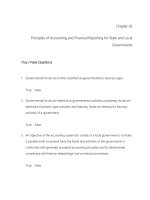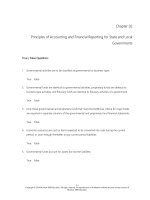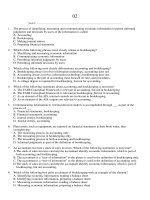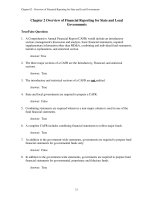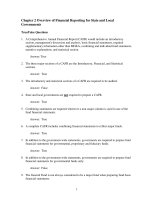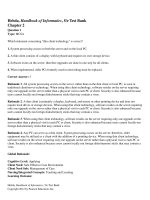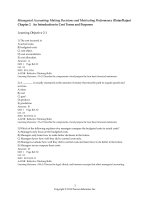Accounting for governmental and nonprofit entities 16th edition reck test bank
Bạn đang xem bản rút gọn của tài liệu. Xem và tải ngay bản đầy đủ của tài liệu tại đây (299.52 KB, 50 trang )
Chapter 02
Principles of Accounting and Financial Reporting for State and Local
Governments
True / False Questions
1. Governmental funds are further classified as governmental or business-type.
True
False
2. Governmental funds are identical to governmental activities, proprietary funds are
identical to business-type activities, and fiduciary funds are identical to fiduciary
activities of a government.
True
False
3. An objective of the accounting system for a state or a local government is to make
it possible both to present fairly the funds and activities of the government in
conformity with generally accepted accounting principles and to demonstrate
compliance with finance-related legal and contractual provisions.
True
False
4. Individual fund financial information is reported in separate columns of
governmental and proprietary fund financial statements for only those funds that
meet the GASB size-related criteria as major funds.
True
False
5. Economic resources are cash or items expected to be converted into cash during
the current period, or soon enough thereafter to pay current period liabilities.
True
False
6. Governmental funds account for assets but not the liabilities.
True
False
7. The types of funds that may be used in governmental accounting are classified
into the three categories of governmental, proprietary, and fiduciary.
True
False
8. The governmental funds category includes the General Fund, special revenue
funds, debt service funds, capital projects funds, and internal service funds.
True
False
9. Governments can, in part, demonstrate operational accountability by reporting
proprietary and fiduciary fund financial information, as well as all government-wide
financial information, using an economic resources measurement focus and the
accrual basis of accounting.
True
False
10. All capital assets acquired by or used by a fund should be reported in the fund
balance sheet or statement of net position.
True
False
11. Because budgetary accounts are used by governments, their financial statements
can never be said to be in accord with generally accepted accounting principles.
True
False
12. Governments must present three sets of fund financial statements.
True
False
13. When revenues are legally restricted by external resource providers or committed
by enabling legislation for particular operating purposes, a private purpose trust
fund is created.
True
False
14. A debt service fund is used to account for financial resources segregated for the
purpose of making principal and interest payments on general long-term debt.
True
False
15. A deferred inflow is defined as “an acquisition of net assets by the government
that is applicable to a future reporting period.”
True
False
16. Expenditures are never recorded in governmental funds.
True
False
Multiple Choice Questions
17. The accounting system used by a state or local government must make it
possible
A. To present fairly the financial position and results of financial operations of the
government as a whole, as well as fund financial activity in conformity with
GAAP.
B. To prepare financial statements as required by the Financial Accounting
Standards Board.
C. To prepare consolidated accrual basis statements for the government as a
whole.
D. To provide Web-based bond offering statements to investment firms.
18. Which of the following is a difference between financial reporting for internal
service and enterprise funds?
A. Internal service funds are reported in the governmental fund financial
statements.
B. Internal service funds are reported in the proprietary fund financial statements.
C. Internal service funds are generally reported in the Business-type Activities
column of the government-wide financial statements.
D. Internal service funds are generally reported in the Governmental Activities
column of the government-wide financial statements.
19. Which of the following is not a characteristic of a fund as defined by GASB
standards?
A. An accounting entity.
B. A fiscal entity.
C. A segregated quantity of cash and other financial resources on deposit with a
designated trustee.
D. A self-balancing set of accounts.
20. In accounting for state and local governments the modified accrual basis is
required for
A. Proprietary and fiduciary funds.
B. Governmental funds only.
C. Proprietary funds only.
D. All funds.
21. Under the modified accrual basis of accounting, revenues should be recognized
when
A. Earned.
B. Collected in cash.
C. Authorized by the budget ordinance.
D. Measurable and available.
22. The accrual basis of accounting applicable to proprietary fund types requires that
exchange revenues be recognized when
A. Earned.
B. Collected in cash.
C. Authorized by the budget ordinance.
D. Measurable and available.
23. Which of the following funds is a governmental fund-type?
A. Private-purpose trust fund.
B. Internal service fund.
C. Permanent fund.
D. Enterprise fund.
24. Financial resources set aside to pay principal and interest on general long-term
debt may be accounted for in which of the following fund types?
A. Private-purpose trust fund.
B. Debt service fund.
C. Principal and interest trust fund.
D. Internal service fund.
25. According to GASB standards transfers should be recognized
A. When earned.
B. When collected in cash.
C. When authorized by the budget ordinance.
D. In the period the interfund receivable and payable arise.
26. Generally accepted accounting principles applicable to state and local
governments require that
A. Only governmental funds and proprietary funds should be established.
B. Only those funds required by law, GASB standards, and sound financial
administration should be established.
C. Only those funds required by law should be established.
D. All categories of funds must be established.
27. Which of the following is a proprietary fund?
A. Special revenue fund.
B. Investment trust fund.
C. Debt service fund.
D. Internal service fund.
28. Which of the following is a fiduciary fund?
A. Investment trust fund.
B. Special revenue fund.
C. Debt service fund.
D. Enterprise fund.
29. Which of the following funds would be most appropriate for accounting for an
activity that provides goods or services to the public for a fee that is intended to
make the activity self-supporting?
A. Investment trust fund.
B. Enterprise fund.
C. Internal service fund.
D. Special revenue fund.
30. Which of the following funds should be used if resources provided by a federal
grant must be segregated and used for counseling of youthful offenders?
A. Private-purpose trust fund.
B. Enterprise fund.
C. Internal service fund.
D. Special revenue fund.
31. Which of the following funds would be used to account for an activity that
provides centralized purchasing and sales of goods or services to other
departments or agencies of the governmental, or to other governments, on a costreimbursement basis?
A. Enterprise fund.
B. Fiduciary fund.
C. Internal service fund.
D. Permanent fund.
32. Budgetary comparison schedules presenting budgeted versus actual revenues and
expenditures are
A. Optional under GASB standards for all funds.
B. Required by GAAP for internal management reports only; not permitted for
external financial reporting.
C. Required by GAAP for the General Fund and major special revenue funds for
which an annual budget has been legally adopted.
D. Required by GAAP for all governmental fund types.
33. In which of the following funds would it not be appropriate to record depreciation
of capital assets?
A. Special revenue fund.
B. Enterprise.
C. Internal service.
D. Pension trust.
34. Capital assets used by departments accounted for by the General Fund of a
governmental unit should be accounted for in
A. The General Fund.
B. The governmental activities journal.
C. The business-type activities journal.
D. The general capital assets fund.
35. Reporting fund financial information in separate columns for each major fund and
aggregate information for nonmajor funds
A. Means that only those funds that meet the GASB's 10 percent and 5 percent
rules are reported in separate columns.
B. Is optional under GAAP, but is generally required by state laws for governments.
C. Is the same manner of reporting used by business organizations.
D. Is required by generally accepted accounting principles for state and local
governments.
36. Capital assets used by an enterprise fund should be accounted for in the
A. Enterprise fund and depreciation on the capital assets should be recorded.
B. Business-type activities journal but no depreciation on the capital assets should
be recorded.
C. Governmental activities journal and depreciation on the capital assets should be
recorded.
D. Enterprise fund but no depreciation on the capital assets should be recorded.
37. Which of the following funds are proprietary funds?
A. Enterprise funds, investment trust funds, pension trust funds, and the General
Fund.
B. Enterprise funds and internal service funds.
C. Internal service funds, special revenue funds, and enterprise funds.
D. Proprietary funds are not used in governmental accounting.
38. Which of the following funds are governmental funds?
A. General Fund, special revenue funds, capital projects funds, debt service funds,
and private-purpose trust funds.
B. General Fund, special revenue funds, private-purpose trust funds.
C. General Fund, special revenue funds, debt service funds, capital projects funds,
and permanent funds.
D. General Fund, special revenue funds, capital projects funds, debt service funds,
and internal service funds.
39. The activities of a water utility department, which offers its services to the general
public on a user charge basis, should be accounted for in
A. An enterprise fund.
B. A special revenue fund.
C. The General Fund.
D. An internal service fund.
40. The measurement focus and basis of accounting that are most unlike those used
by business entities are those used by
A. Governmental funds.
B. Fiduciary funds.
C. Proprietary funds.
D. Contribution funds.
41. Which of the following must be reported as a major fund?
A. The General Fund.
B. A fund having total assets, liabilities, revenues, or expenditures/expenses
equaling at least 10 percent of the total governmental or enterprise fund
amount for the same element (assets, liabilities, and so forth), as applicable, and
at least 5 percent of the combined governmental and enterprise fund total
amount for the same element.
C. Both a and b.
D. Neither a nor b.
42. The basis of accounting that should be used in preparing fund financial statements
is:
A. Choice A
B. Choice B
C. Choice C
D. Choice D
43. A major governmental fund is one that has one or more elements (e.g., assets,
liabilities, revenues, or expenditures) that is at least:
A. Five percent of the corresponding element(s) of total governmental funds and
10 percent of the corresponding element(s) of total governmental and
enterprise funds combined.
B. Ten percent of the corresponding element(s) of total governmental funds and 10
percent of the corresponding element(s) of total governmental and enterprise
funds combined.
C. Five percent of the corresponding element(s) of total governmental funds and
five percent of the corresponding element(s) of total governmental and
enterprise funds combined.
D. Ten percent of the corresponding element(s) of total governmental funds and 5
percent of the corresponding element(s) of total governmental and enterprise
funds combined.
Short Answer Questions
44. The following are categories of funds described in Chapter 2:
A. Governmental funds
B. Proprietary funds
C. Fiduciary funds
For each of the following descriptive phrases, indicate the type of fund from the list
above that best matches by placing the appropriate letter in the blank space next
to the phrase.
Essay Questions
45. Explain the difference between measurement focus and basis of accounting. Also,
explain the difference between the economic resources measurement focus and
the current financial resources measurement focus as well as the difference
between the accrual and modified accrual bases of accounting. Which funds and
government-wide activities use each focus and each basis?
46. "The primary purpose of an accounting system for a state or a local government is
to make it possible for financial statements to demonstrate compliance with
finance-related legal and contractual provisions." Explain why you believe this
statement to be correct or incorrect.
47. Describe the basic financial statements required by GASB standards and briefly
explain their purposes.
48. "Because budgetary accounts are used by governments, their financial statements
can never be said to be in accord with generally accepted accounting principles."
Comment.
49. List the seven fund financial statements that are required as part of the basic
financial statements by GASB standards. What measurement focus and basis of
accounting should be used in preparing each of these statements?
50. Explain the nature of the three major activity categories of a state or local
government: governmental activities, business-type activities, and fiduciary
activities. Provide examples of each.
51. Describe the comprehensive annual financial report (CAFR) described in the
Annual Financial Reports principle. What are the sections of the report and which
components of the organization should it include? Is a CAFR required?
Chapter 02 Principles of Accounting and Financial Reporting for State and
Local Governments Answer Key
True / False Questions
1.
Governmental funds are further classified as governmental or business-type.
FALSE
At the government-wide level, activities are classified as governmental or
business-type.
Difficulty: Easy
Question Type: Concept
2.
Governmental funds are identical to governmental activities, proprietary funds
are identical to business-type activities, and fiduciary funds are identical to
fiduciary activities of a government.
FALSE
There is a similarity among these pairs of terms; however, they are not a one-toone match. For example, activities and funds may use different measurement
focuses and bases of accounting; and the internal service fund is a proprietary
fund, but most often will be reported along with governmental activities, not
business-type activities.
Difficulty: Easy
Question Type: Concept
3.
An objective of the accounting system for a state or a local government is to
make it possible both to present fairly the funds and activities of the
government in conformity with generally accepted accounting principles and to
demonstrate compliance with finance-related legal and contractual provisions.
TRUE
This is consistent with the discussion in Chapter 2.
Difficulty: Easy
Question Type: Concept
4.
Individual fund financial information is reported in separate columns of
governmental and proprietary fund financial statements for only those funds
that meet the GASB size-related criteria as major funds.
FALSE
While it is true that only major funds are reported in separate columns of the
fund financial statements mentioned, funds that do not meet the 10 percent and
5 percent criteria may also be reported as major if government managers feel
they are of significant importance to financial statement users.
Difficulty: Medium
Question Type: Concept
5.
Economic resources are cash or items expected to be converted into cash
during the current period, or soon enough thereafter to pay current period
liabilities.
FALSE
The definition provided describes current financial resources, not economic
resources. Governmental type funds report on the inflows and outflows of
current financial resources; proprietary and fiduciary funds report on the inflows
and outflows of economic resources.
Difficulty: Easy
Question Type: Concept
6.
Governmental funds account for assets but not the liabilities.
FALSE
Under the modified accrual basis of accounting, governmental funds account for
current assets and liabilities but not long-term assets or liabilities.
Difficulty: Easy
Question Type: Concept
7.
The types of funds that may be used in governmental accounting are classified
into the three categories of governmental, proprietary, and fiduciary.
TRUE
Funds are classified as governmental, proprietary, and fiduciary.
Difficulty: Easy
Question Type: Concept


